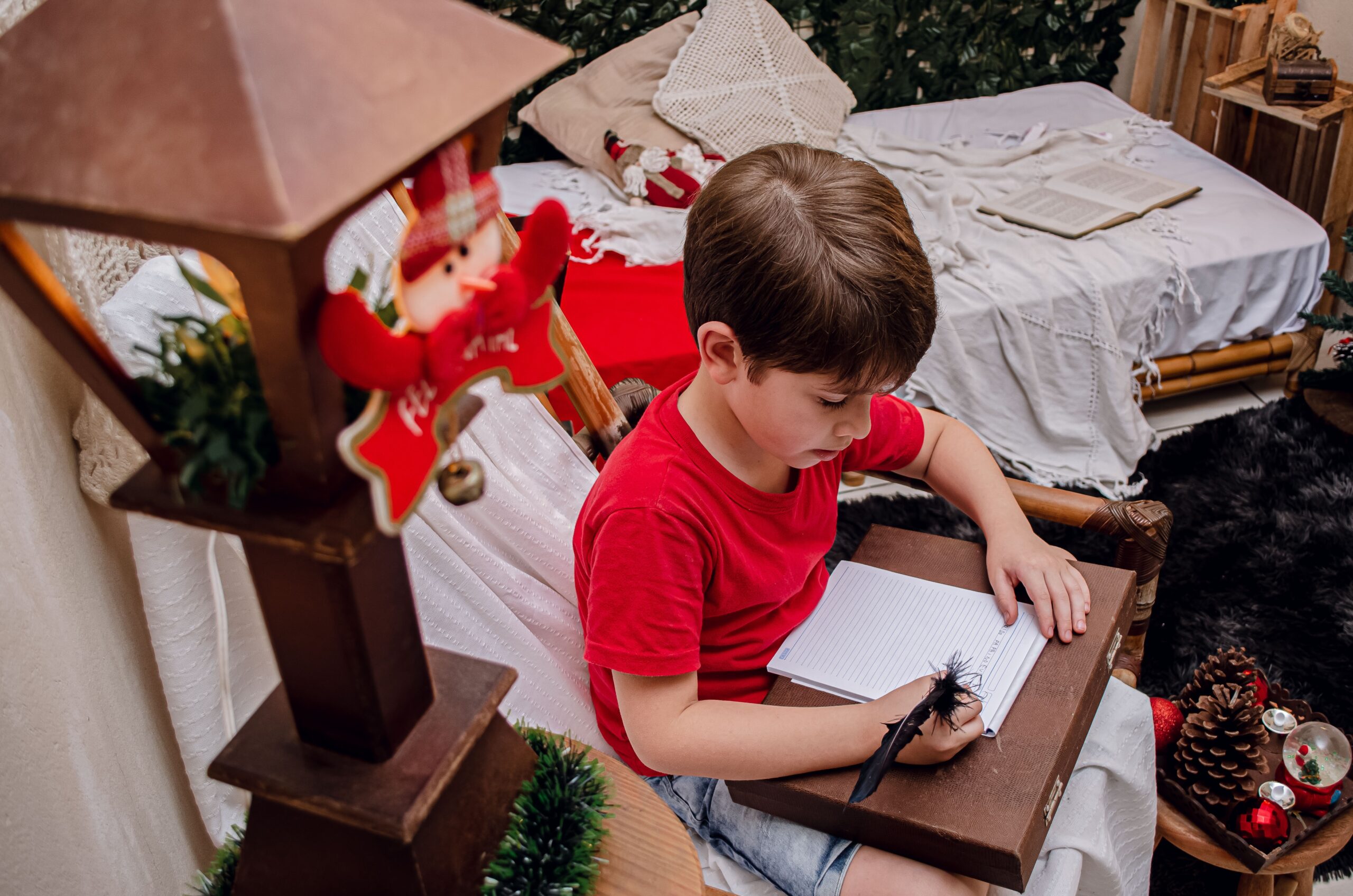6 Engaging Writing Activities For Christmas

Christmas! A season full of wonder, but also one that easily becomes busy and hectic. Finding ways to simplify and streamline your homeschool helps avoid overwhelm. Why not take a break from your regular language arts activities to focus your family’s reading and writing around Christmas themes? Consider trying some of the writing ideas below.
1) Write Christmas Lists
Children enjoy making wishlists of gifts they’d like to receive. Flipping that idea around, they could also create a giving list, highlighting the people they’d like to give something to. How about a list of favorite Christmas foods? Or a list of their favorite family Christmas traditions. They could write up a guest list for Christmas dinner or a list of the Christmas events your family will be attending. A list of your family’s favorite Christmas books and movies could be kept and added to each year.
2) Meaningful Christmas Copywork
Copywork helps build our children’s vocabulary, models correct grammar and spelling, and provides meaningful handwriting practice. You can read more about the value and practice of copywork here. Christmas themes present a range of opportunities for meaningful copywork. For example:
- Make place cards for Christmas dinner. The children can design or decorate these cards, or find a template online. Have fun with Christmas shapes like Christmas trees or stars or Christmas stockings. The children can write each guest or family member’s name on a place card. You might like to include a famous Christmas quote or Bible verse. Some suggested verses are Isaiah 9:6, Matthew 1:21, Matthew 1:23, Luke 1: 35, Luke 2:7, Luke 2:10-11, John 1:14, John 3:16, 2 Corinthians 8:9, 2 Corinthians 9:15.
- Copy and decorate Christmas carols, songs, or poems. Use these as posters or give them as gifts.
- Copy and decorate favorite Christmas recipes. These make great presents, especially if a sample of the treat is included. A personal note on the back of the recipe card makes the gift even more memorable and special.
- Write Christmas Scripture verses on index cards or decorative paper. These can serve as decorations or give them to friends to provide Christmas inspiration.
- Write Christmas cards. Make or purchase Christmas cards. Older children can write their own messages to friends or family members and younger ones can dictate a message and then copy their own words into the cards.
An easy way to make Christmas copywork look more attractive is to use the free Christmas Notebooking pages provided by Notebooking.com. They offer a range of Christmas templates, including foldable Christmas card designs and recipe cards.
3) Write a Christmas story
A season of wonder like Christmas provides lots of scope for creative story writing. If children are looking for an inexpensive, creative, one-of-a-kind gift for a friend or relative, a story might be just the thing.
One fun way to create a story is to take a different perspective on a familiar narrative. For example, after reading the biblical Christmas story, you could brainstorm with your children some of the different perspectives they could take. How would one of the angels who announced the news to the shepherds tell the story? Or a shepherd who heard the angel’s announcement? What about the innkeeper’s wife or child? How might one of the wise men from the east relate the story to his grandchild? Or maybe one of the wise men’s camels would have an interesting tale to tell.

When our youngest was six, she was inspired by Max Lucado’s Christmas story, The Crippled Lamb. Tweaking his idea, she dictated a story called Skip’s First Christmas Adventure about a stubborn little lamb who got lost and ended up wandering into the stable where Jesus had been born. When the shepherds came to see baby Jesus, the little lamb was found. She enjoyed telling and illustrating this story and gave copies as a gift to a couple of her friends.
Another simple way to make a Christmas story is to adapt a fable or other familiar story and give it a Christmas twist. Years ago when I was teaching, one of my immigrant students who had basic English needed to write a Christmas story for his fifth-grade language arts class. Having just read the fable, The Tortoise and the Hare, he used that story framework to write and illustrate a fun story called Santa and the Reindeer.
Your child might have a story idea that’s not related to Christmas. That works, too! One of my daughters enjoyed reading The LIttles series. Inspired by those books, she wrote a sequel story about the tiny characters, illustrated it, and gave copies as Christmas presents to her friends. Since the characters were already created, she just had to come up with a workable plot.
Sometimes it’s fun to work together as a family to write a story. Brainstorm ideas and see where it takes you. Helpful and engaging resources can be found at SuperEasyStorytelling.com.
4) Write a Christmas acrostic poem.
Take the word CHRISTMAS or a Christmas theme word like EMMANUEL or SAVIOR or SANTA and create an acrostic poem. Working together, think of relevant words that start with each of the letters. See how many Christmas-themed words you can think of for each letter. Alternatively, you could think of a phrase or sentence starting with each letter of the chosen word. I grew up with a Jim Reeves version of a C-H-R-I-S-T-M-A-S acrostic song. The lyrics of that song might serve as inspiration. Rhymes can be added if you feel inspired, but the main point is to be creative and have fun.
Another option is to take the name of someone special, like GRANDMA or a friend and make an acrostic poem in their honor, listing words or phrases that describe the person. A poem like this makes a meaningful gift for the chosen person.
Acrostic poems make great posters, Christmas cards or gifts. Your children can have fun designing and decorating the poems once they are copied out or typed up.
5) Research and write about a Christmas tradition
Christmas is full of interesting traditions like Christmas trees, Santa Claus, gift-giving, Christmas stockings, Christmas caroling, and mistletoe. Where did these traditions come from? What’s the origin of Boxing Day? Why was December 25th chosen as the date to celebrate Jesus’ birthday? How is Christmas celebrated in other countries?
Which of these questions sparks your children’s curiosity? Or maybe your children have a question about a different Christmas tradition. Another idea is to research the background of a favorite Christmas song or carol.
Invite your children to be detectives and investigate one or more of these traditions. They can write or dictate to you what they find out. To add interest, they could present what they find in an interview format. Their newfound knowledge could be shared with your guests on Christmas Day. Another fun way to present what they learn is to make a Did You Know book or poster, compiling the facts and adding some photos or drawings.
6) Write Christmas letters
Most of us are familiar with the idea of kids writing letters to Santa at Christmas. Here are some other Christmas letter ideas.
If you send an annual Christmas newsletter to friends, consider asking each child to write a few lines about their highlights from the year. Younger ones could dictate their ideas. If children handwrite their responses, you might like to take a picture of their contributions and add them that way. Older children may prefer to type their thoughts. Whether your children’s highlights are typed-up or handwritten, friends and family would enjoy hearing directly from them.
My daughter reminded me that some years, each person in our family wrote a letter to Jesus at Christmas. Besides thanking him for entering our world, we also chose one character quality that we particularly wanted to grow in during the coming year as a gift to him.
Patience, kindness, and self-control were popular choices. (I’m sure patience was my top choice!) We found and included a verse or two related to the chosen trait. Saving the letters, we referred to them throughout the year as reminders and encouragements. This idea could be adapted in various ways depending on the age and stage of one’s children. (For more Christmas traditions that focus on Jesus, click here.)
If your family is not religious, this activity could be adapted with family members writing a letter to themselves for the next year, choosing a character quality they want to improve on. Including some famous proverbs or quotes from famous people they admire could provide inspiration and encouragement.
Your turn
Which of these writing activities would your children enjoy? Which ideas could you try this year? Whichever you choose, engage with your children and support them as much as needed to set them up for success. Light some candles and have fun writing together. Perhaps you’ll start a new Christmas tradition.
I’d love to hear about any Christmas writing projects your family has enjoyed. Send me a message and let me know.






